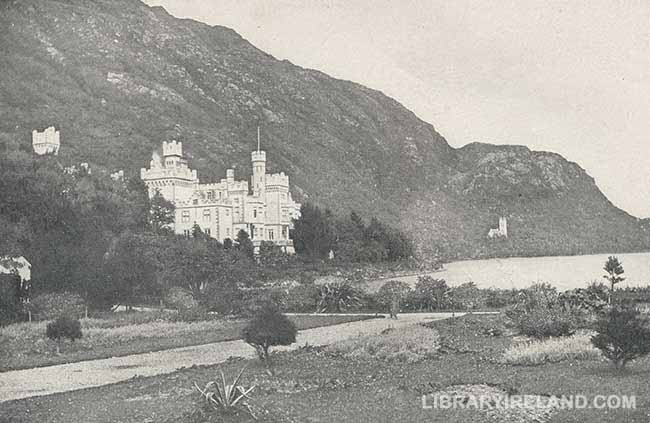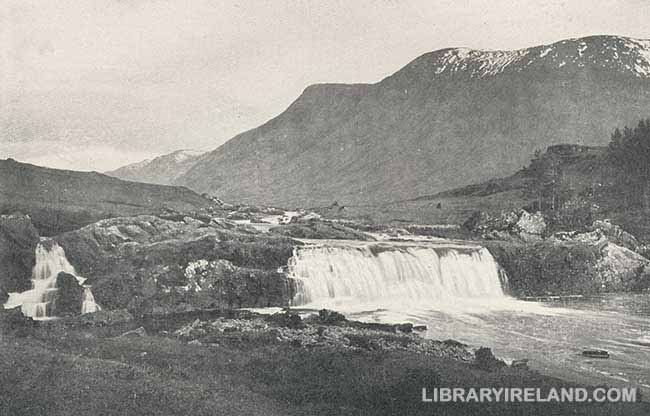Kylemore Castle
Next morning the landlady furnished us with the best animal we had on the trip. She was a stout, bay mare, and when her spirits had rallied after leaving a young colt of hers behind, she reeled off the miles like a machine. Our object in visiting this part of the country was to see Mitchell Henry's famous castle, Kylemore, and the Twelve Pins, about which we had been hearing all our lives without ever having had an opportunity to visit them until now.

Kylemore Castle and Private Chapel, County Galway
Mr. Henry was a linen merchant, with houses in Belfast and Manchester; he made a fortune, purchased fourteen thousand acres of land in Connemara to give himself a political foothold, and in consequence became M. P. for Galway, which position he retained for six years. About forty years ago he began the construction of Kylemore, selecting as a site a valley between very high mountains, with a lake and river in front of the spot where his castle would stand. He collected rare trees and planted the mountain-sides with them, as well as the valley round his buildings. In addition to the castle, he erected fine stables, a private chapel, sheltered gardens, and conservatories, and preserved the salmon and trout in the lake and river. The moist heat from the Gulf Stream was his main ally, and nowhere else in the world can more bursting vigor and splendid growth be seen than are exhibited by his trees, shrubs, and flowers; to see them is a veritable treat to those who are interested in such things. In the gardens flourish groups of tropical plants, palms, and rare ferns the year round; they need no protection in this mild climate. His roads have double fuchsia hedges twelve feet high, which, anywhere else than in Connemara, would be worth a fortune. They were in full bloom when we saw them.
Mr. Henry is now a very old man and lives in London; and the sad part of it all is that he cannot enjoy the glories of his famous property, and it is for sale. Sic transit gloria mundi! After visiting the castle, church, gardens, and conservatories, we drove through the extensive, finely wooded demesne, passing vast banks of rhododendrons and hydrangeas in rare bloom, till we reached the county road and caught our first glimpse of the Twelve Pins, or Bens, as they are sometimes called. They were a disappointment; we had heard too much about them. The Twelve Pins is a group of high mountains having but little verdure; the highest, Benbaun, is two thousand four hundred feet above sea-level. The remarkable feature about them is that they are practically one long mountain with twelve peaks rising from it at regular intervals. Excepting this startling effect, they do not compare with Muckish, Dooish, or Errigal, the "peerless cone" of Donegal.
The bay mare carried us in gallant style past the long, romantic-looking Lough Inagh down to Recess, where we put up at the best hotel we had found since we started.

Devil's Mother Mountain and Aasleagh Falls, County Galway
Read "On an Irish Jaunting Car through Donegal and Connemara" at your leisure
Read On an Irish jaunting Car through Donegal and Connemara at your leisure and help support this free Irish library.
Samuel Gamble Bayne was born in Ramelton, County Donegal, and educated at Queen's University in Belfast. At the age of twenty-five he left for America with a view to making his fortune. He invested in an oil well in Pennsylvania and later founded a bank which subsequently came to be the JP Morgan Chase bank in New York. By the time this book was written he was wealthy enough to be referred to as a billionaire. His account of the tour through the north, west and south of Ireland is a pleasant snapshot of how that part of the country was in the early part of the 20th century. He describes what is to be seen, gives some background history and, through the illustrations especially, provides wonderful glimpses of the area's social history.
The ebook is available in .mobi, .epub, and .pdf formats. See details ».

